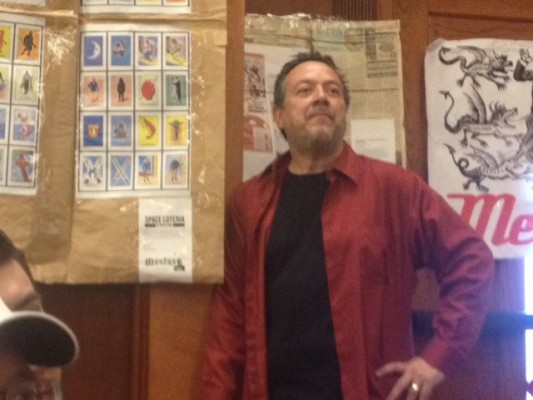EL PASO— The Mexican experience in America, presented with verve as a celebration of the culture and and as a bulwark against negative stereotypes in popular art and media was dubbed Mextasy by Dr. William Anthony Nericcio.
“This anti-Mexican fervor needs to be met with a kind of invocation of mexicanidad that needs to be equally strong,” Nericcio says. “You got to attack it with the same power with the same fervor, with the same dynamic focus.”

Dr. William Anthony Nericcio’s Mextasy pop-up exposition contains artifacts he’s collected over the years representing perceptions of Mexican ethnic identities in the United States.
Nericcio captivated a room of faculty members and students when he came to the University of Texas at El Paso recently to discuss and present his travelling art show,
TheMextasypop-up exposition contains objects that Nericcio has collected over the years, Ranging from dolls to posters that harken back to the 1950’s representing and satirizing the Mexican experience in the United States, representing an analysis of Hollywood’s contribution to perceptions of Mexican ethnic identities.
Nericcio gets serious when addressing how consumers should fight the negative commentary on Mexicans that some commentators in media like Rush Limbaugh and Anne Coulter advocate.
Ectasy healing
For Nericcio, Mextasy can be seen as a form of defense and cure against those Mexican stereotypes and tropes. Presentations like Mextasy can heal society just like creating the art healed Nericcio.
“For me, a lot of this work, this artwork is recuperative.” Nericcio explains, “It’s me paying for my sins, and trying to imagine another way of being in touch with my innerMextasy.”
Nericcio, a Texas-born professor of Chicano Studies and Latin American Studies, English and Comparative Literature at San Diego State University, explains that the origins of the titleMextasycome from the word ecstasy and both the physical and spiritual pleasure that the word may convey.
“The first thing to know aboutMextasyis that I want you to be associating it with pleasure not necessarily always sexual pleasure, but the ecstasy of pleasure.” Nericcio says.“The pleasure, the drug, the transportation of the spirit are built into the show and it is ultimately all about the pleasure of being Mexican.” Nericcio says.
Nericcio, a confessed visual artist and graphic designer, designed the majority of images and posters featured in the exhibition.
“I design books. I do graphic narrative. I used to be a cartoonist,” Nericcio states. “I thought to myself I’ll do a show, one half artifacts, one half my own art.”
The exhibition also includes artwork from other Chicano artists including Izel Vargas and Rio Yañez.
Questioning stereotypes in popular visual culture
The lecture/exhibition is also centered on Nericcio’s 2007 book titledTex{t}-Mex: Seductive Hallucinations of the “Mexican” in America.The book is a study on Mexican stereotypes found in popular culture.
“It’s about every stereotype of Mexicans you ever run across on TV, in the movies, on billboards, in the newspapers,” Nericcio says. “… If the United States of America has done anything in its two hundred and something years, is produced some memorable stereotypes of Mexicans.”
Unlike many scholarly writings,Tex{t}-Mexis written in a conversational style. The book features Nericcio’s sarcastic humor and personal anecdotes.Tex{t}-Mexalso includes the examination of popular characters and icons such as Speedy Gonzales, Frito Bandito, Orson Welles, Rita Hayworth and Lupe Velez.
“He writes about popular culture and culture in general and history in general,” said Dr. RobertoAvant-Mier, an associate professor of Communication andMedia Studies at UTEP. “For me the part about his books that I’m interested is when he focuses on movies and television shows and other cultural references.”
Avant-Mier also said that Nericcio’s findings are fascinating because he takes seriously the images and representations of Mexicans in popular culture.
“He deconstructs them and he analyzes them and I think that is what his work does,” Avant-Mier says “He’s forcing us to think about them, to ask questions about what they mean, what they say and what they do.”
